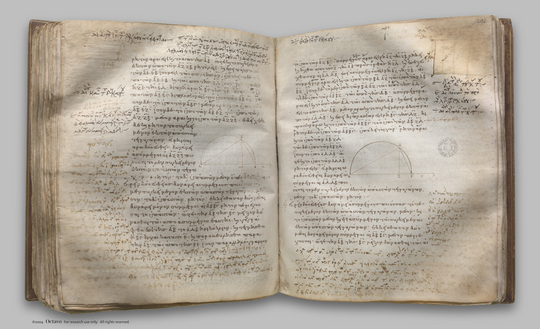index prev next | digilib folio 207

To find two straight lines incommensurable in square which make the sum of the squares on them medial but the rectangle contained by them rational.
| Εὑρεῖν δύο εὐθείας δυνάμει ἀσυμμέτρους ποιούσας τὸ μὲν συγκείμενον ἐκ τῶν ἀπ' αὐτῶν τετραγώνων μέσον, τὸ δ' ὑπ' αὐτῶν ῥητόν. Ἐκκείσθωσαν δύο μέσαι δυνάμει μόνον σύμμετροι αἱ ΑΒ, ΒΓ ῥητὸν περιέχουσαι τὸ ὑπ' αὐτῶν, ὥστε τὴν ΑΒ τῆς ΒΓ μεῖζον δύνασθαι τῷ ἀπὸ ἀσυμμέτρου ἑαυτῇ, καὶ γεγράφθω ἐπὶ τῆς ΑΒ τὸ ΑΔΒ ἡμικύκλιον, καὶ τετμήσθω ἡ ΒΓ δίχα κατὰ τὸ Ε, καὶ παραβεβλήσθω παρὰ τὴν ΑΒ τῷ ἀπὸ τῆς ΒΕ ἴσον παραλληλόγραμμον ἐλλεῖπον εἴδει τετραγώνῳ τὸ ὑπὸ τῶν ΑΖΒ: ἀσύμμετρος ἄρα [ ἐστὶν ] ἡ ΑΖ τῇ ΖΒ μήκει. καὶ ἤχθω ἀπὸ τοῦ Ζ τῇ ΑΒ πρὸς ὀρθὰς ἡ ΖΔ, καὶ ἐπεζεύχθωσαν αἱ ΑΔ, ΔΒ. Ἐπεὶ ἀσύμμετρός ἐστιν ἡ ΑΖ τῇ ΖΒ, ἀσύμμετρον ἄρα ἐστὶ καὶ τὸ ὑπὸ τῶν ΒΑ, ΑΖ τῷ ὑπὸ τῶν ΑΒ, ΒΖ. ἴσον δὲ τὸ μὲν ὑπὸ τῶν ΒΑ, ΑΖ τῷ ἀπὸ τῆς ΑΔ, τὸ δὲ ὑπὸ τῶν ΑΒ, ΒΖ τῷ ἀπὸ τῆς ΔΒ: ἀσύμμετρον ἄρα ἐστὶ καὶ τὸ ἀπὸ τῆς ΑΔ τῷ ἀπὸ τῆς ΔΒ. καὶ ἐπεὶ μέσον ἐστὶ τὸ ἀπὸ τῆς ΑΒ, μέσον ἄρα καὶ τὸ συγκείμενον ἐκ τῶν ἀπὸ τῶν ΑΔ, ΔΒ. καὶ ἐπεὶ διπλῆ ἐστιν ἡ ΒΓ τῆς ΔΖ, διπλάσιον ἄρα καὶ τὸ ὑπὸ τῶν ΑΒ, ΒΓ τοῦ ὑπὸ τῶν ΑΒ, ΖΔ. ῥητὸν δὲ τὸ ὑπὸ τῶν ΑΒ, ΒΓ: ῥητὸν ἄρα καὶ τὸ ὑπὸ τῶν ΑΒ, ΖΔ. τὸ δὲ ὑπὸ τῶν ΑΒ, ΖΔ ἴσον τῷ ὑπὸ τῶν ΑΔ, ΔΒ: ὥστε καὶ τὸ ὑπὸ τῶν ΑΔ, ΔΒ ῥητόν ἐστιν. Εὕρηνται ἄρα δύο εὐθεῖαι δυνάμει ἀσύμμετροι αἱ ΑΔ, ΔΒ ποιοῦσαι τὸ [ μὲν ] συγκείμενον ἐκ τῶν ἀπ' αὐτῶν τετραγώνων μέσον, τὸ δ' ὑπ' αὐτῶν ῥητόν: ὅπερ ἔδει δεῖξαι. | To find two straight lines incommensurable in square which make the sum of the squares on them medial but the rectangle contained by them rational. Let there be set out two medial straight lines AB, BC, commensurable in square only, such that the rectangle which they contain is rational, and the square on AB is greater than the square on BC by the square on a straight line incommensurable with AB; [X. 31, ad fin.] let the semicircle ADB be described on AB, let BC be bisected at E, let there be applied to AB a parallelogram equal to the square on BE and deficient by a square figure, namely the rectangle AF, FB; [VI. 28] therefore AF is incommensurable in length with FB. [X. 18] Let FD be drawn from F at right angles to AB, and let AD, DB be joined. Since AF is incommensurable in length with FB, therefore the rectangle BA, AF is also incommensurable with the rectangle AB, BF. [X. 11] But the rectangle BA, AF is equal to the square on AD, and the rectangle AB, BF to the square on DB; therefore the square on AD is also incommensurable with the square on DB. And, since the square on AB is medial, therefore the sum of the squares on AD, DB is also medial. [III. 31, I. 47] And, since BC is double of DF, therefore the rectangle AB, BC is also double of the rectangle AB, FD. But the rectangle AB, BC is rational; therefore the rectangle AB, FD is also rational. [X. 6] But the rectangle AB, FD is equal to the rectangle AD, DB; [Lemma] so that the rectangle AD, DB is also rational. |